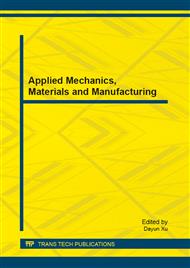[1]
Industry news: Advanced Materials and Processes, Vol. 171 (2013), No. 2, p.8.
Google Scholar
[2]
NREL Report: Photovoltaic Cell Conversion Efficiency,. Available at http: /www. nrel. gov/ncpv.
Google Scholar
[3]
Y-C Si: Principle and technology of solar energy", Xi, an Jiaotong University Press, Xian, (2010), p.103.
Google Scholar
[5]
M.A. Green et al: Research and Applications, Vol. 18 (2010), No. 2, pp.144-150.
Google Scholar
[6]
D.S. Kima et al: Solar Energy Materials and Solar Cells, Vol. 90 (2006), No. 9, pp.1227-1240.
Google Scholar
[7]
S.Y. Myong et al: Semiconductor Science and Technology, Vol. 21 (2005), No. 2, pp L11-L15.
Google Scholar
[8]
Stuttgart solar researchers bring a world record to Germany, at http: /www. solar-consulting. de.
Google Scholar
[9]
M.K. Nazeeruddin et al: Journal of the American Chemical Society, Vol. 127 (2005), p.16835–16847.
Google Scholar
[10]
H. Chen et al: Photonics, Vol. 3 (2009), No. 11, pp.649-653.
Google Scholar
[11]
Industry News, Advanced Materials & Processes, Vol. 170 (2012), No. 11, p.11.
Google Scholar
[12]
E. Shi et al: Scientific Reports, Vol. 2 (2012), pp.884-888.
Google Scholar
[13]
S.J. Oh et al: Physics Express, Vol. 21 (2013), No. S1, pp. A157-A166.
Google Scholar
[14]
C.R. Simovski et al: Condensed Matter; arXiv: 1301. 3290v1.
Google Scholar
[15]
M. D, Johnston and M. Barati: Journal of Metals, Vol. 64 (2012), No. 8, pp.935-945.
Google Scholar
[16]
K. Tang, S. Andersson and M. Tangstad: Journal of Metals, Vol. 64 (2012), No. 8, pp.952-956.
Google Scholar
[17]
Y.Y. Ong et al: Journal of Physics: Conference Series, Vol. 34 (2006), No. 1, p.812–817.
Google Scholar
[18]
S. Y. Myong et al: Applied Physics Letters, Vol. 90 (2007), No. 26, pp.263509-1.
Google Scholar
[19]
D.S. Vilamitjana: PhD thesis, University of Barcelona (2004).
Google Scholar
[20]
M. A. Green: Journal of Material Science: Materials in Electronics, Vol. 18 (2007), No. 1, pp.15-19.
Google Scholar
[21]
W.D. Johnston et al: Journal of Electrochemistry Society, Vol. 127 (1980), No. 1, pp.90-95.
Google Scholar
[22]
M. Khizar et al: Proc. of High Capacity Optical Networks and Enabling Technologies, 2011, Riyadh.
Google Scholar
[23]
J.J. Schermer et al: Thin Solid Films, Vol. 511-512 (2006), pp.645-653.
Google Scholar
[24]
G.J. Bauhuis et al: Solar Energy Materials and Solar Cells, Vol. 83 (2004), pp.81-90.
Google Scholar
[25]
2009 Annual Report, First Solar, Tempe, Arizona (2009).
Google Scholar
[26]
Information at http: /www. researchandmarkets. com.
Google Scholar
[27]
V. Kumar, J.K. Gaur1 and T.P. Sharma: Chalcogenide Letters, Vol. 5 (2008), No. 8, p.171 – 176.
Google Scholar
[28]
M. Burgelman, Thin film solar cells by screen printing technology, in Proc. Workshop Microtechnology and Thermal Problems in Electronics, (1998), pp.129-135.
Google Scholar
[29]
W. T. Pawlewicz, R.P. Allen and N. Laegreid: Revue de Physique Appliquée, (1977), p.417.
Google Scholar
[30]
A.D. Compaan et al: Available at http: /gopher. udel. edu/iec/pubs/RWBpubs/RWB90. pdf.
Google Scholar
[31]
V.M. Fthenakis: Renewable and Sustainable Energy Reviews, Vol. 8 (2004), p.303–334.
Google Scholar
[32]
U.S. Geological Survey, Tellurium, Information on http: /minerals. usgs. gov.
Google Scholar
[33]
I. Kapilevich and A. Skumanich: Proc. IEEE PVSC (2009).
Google Scholar
[34]
P. Jackson et al: Progress in Photovoltaics: Research and Applications, Vol. 15 (2007), No. 6, p.507.
Google Scholar
[35]
A. M. Hermanna et al: Solar Energy Materials & Solar Cells, Vol. 70 ( 2001), No. 3, p.345–361.
Google Scholar
[36]
V.K. Kapur, M. Fisher and R. Roe: MRS Proceedings, Vol. 668 (2001).
Google Scholar
[37]
Information available at http: /photochemistry. epfl. ch/EDEY/III-V_physics. pdf.
Google Scholar
[38]
D.C. Lawa et al: Solar Energy Materials & Solar Cells, Vol. 94 (2010), No. 8, pp.1314-1318.
Google Scholar
[39]
Information available at http: /boeing. mediaroom. com/index. php?s=43&item=810.
Google Scholar
[40]
R. Janssen: Introduction to Polymer Solar Cells, Eindhoven University of Technology, Netherlands.
Google Scholar
[41]
M. Grätzel: J. of Photochemistry and Photobiology C: Photochemistry Reviews, Vol. 4 (2003), p.145.
Google Scholar
[42]
F. Kong, S. Dai and K. Wang: Advances in OptoElectronics, Vol. 2007 (2007), Article ID 75384.
Google Scholar



